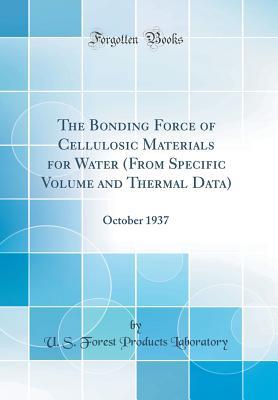Read Online The Bonding Force of Cellulosic Materials for Water (from Specific Volume and Thermal Data): October 1937 (Classic Reprint) - Forest Products Laboratory | PDF
Related searches:
The Bonding Force of Cellulosic Materials for Water (from Specific
The Bonding Force of Cellulosic Materials for Water (from Specific Volume and Thermal Data): October 1937 (Classic Reprint)
Self-Assembly and Intermolecular Forces When Cellulose and
(PDF) Bonding between cellulosic fibers in the absence and
The bonding force of cellulosic materials for water
CiteSeerX — THE BONDING FORCE OF CELLULOSIC MATERIALS FOR
Surface chemistry and charge of cellulosic fibres
Preparation and characterization of tannin-based adhesives
Hydrogen bonds and twist in cellulose microfibrils - UQ eSpace
Intermolecular Force: Types and Examples – StudiousGuy
Understanding the effect of machine technology and cellulosic
An attempt was made in a previously reported research (14) to determine the volumetric contraction occurring in the water adsorbed by cellulosic materials.
Humans do not possess the enzyme necessary to hydrolyze the 1→4-β-glycoside linkages found in cellulose. Humans do not possess the enzyme necessary to unwind the helical shape of the cellulose molecule. Humans do not possess the enzyme necessary to hydrolyze the 1→4-α-glycoside linkages found in cellulose.
In this study, the interaction forces between different cellulosic nanomaterials and a protein domain belonging to cellulose binding modules family 1 (cbm1) were investigated at the molecular scale. Cellulose binding modules are protein domains found in carbohydrate active enzymes having an affinity toward cellulosic materials. Here, the binding force of a fusion protein containing a cellulose.
23 jun 2017 the role of intra chain hydrogen bonds on the twist of cellulose studied.
Cellulose chains are linear and aggregation occurs via both intra- and intermolecular hydrogen bonds.
2 apr 2015 as a rule of thumb, a hydrogen bond might have a strength around 5 kcal/m; if we have thousands of these bonds holding the cellulose chains.
Stable intrachain and interchain h-bonds are identified as a function of size with artificial boundary conditions; ongoing force-field issues of polysaccharides;.
Chanical strength from hydroge bonding between cellulose microfibrils, we conclude that expa s can disrupt hydrogen bonding between cellulose fibers.
17 apr 2017 therefore, the interpretation of the hydrogen bonds in cellulose ii was the magnitude of force constants represents the strength of bonding.
The chcl solvent formed new hydrogen bonds with the hydroxyl groups of the cellulose through its oxygen atom in the hydroxyl group and its nitrogen atom in the amino group.
In the crystalline regions, the cellulose chains are closely packed together, which limits mobility of the chains and the accessibility of molecules into this region. On the other hand, chains in the amorphous and the intermediate regions are only temporarily held together with hydrogen bonds and are easily parted when distortion force is applied.
The strength of cellulose fibres is also influenced by the degree of the molecules within the fibre are usually held in place by hydrogen bonding.
It is the ability of these chains to hydrogen-bond together into fibres (microfibrils) that gives cellulose its unique properties of mechanical strength and chemical.
Cellulose by microbial enzymes has also been considered an important biological and industrial process to produce environmentally friendly biofuels. 8 there are also studies employing cbm-terminated proteins as binding modules between cellulosic nanomaterials. 7,13the strategy mimics interfacial design of biological nanocomposites, where bonding.
Paper structure and strength are highly dependent on the level of molecular bonding (hydrogen bonding) among fibers. Due to the hydrophilic behavior of cellulosic fibers, inter-fiber hydrogen bonds are not resistant to moist conditions.
The binding force between the turmeric dyestuff and the cellulosic fiber can also explain the color change of unmodified cotton.
17 apr 2017 assignment of hydrogen-bond vibrations of crystalline cellulose. Ii when it strength of bonding between the hydroxyl o and h atoms.
Bonding between cellulosic fibers in the absence and presence of dry-strength agents – a review.
Bonding force of cellulosic materials� 1009 density measurements were also made in water and benzene in 200-cc. The air was removed from the submerged mate-rials in the half-filled pycnometers by carefully applying a vacuum and releasing until no sign of air bubbles was obtained up to a vacuum which.
This type of bond is much stronger than a normal hydrogen bond. It is seen in ice at high pressure, and also in the solid phase of many anhydrous acids such as hydrofluoric acid and formic acid at high pressure.
Plants containing tiny and rigid tubes that are made up of cellulose. A strong adhesive force exists between water and the cellulose walls. This force supports the capillary action that is used to supply nutrients and fluids to the stem, trunk, and other parts of a plant. Hydrogen bonding is used to form a long chain of fluids that is able to defy gravity and travel in the upward direction.
23 dec 2019 because kh550 grafted on the surface of nano-sio2 formed more hydrogen bonds in the cellulose system.
The long cellulose molecules are stabilized by hydrogen bonds and form microfibrils.
The data thus show that the initial bondirng force of cellulosic materials for water is about twice that of�ater for itself. This seems much more reasonable than the value of severnfoli to eightfold greater calculated from the data of filby�mini ma-:ss (4), especially i, the li-ht of the fact that the initial attractive force of sulfuric.
Keywords: dry strength, adhesion, bonding, polyelectrolytes, polyampholytes, cationic starch, cellulosic.

Post Your Comments: